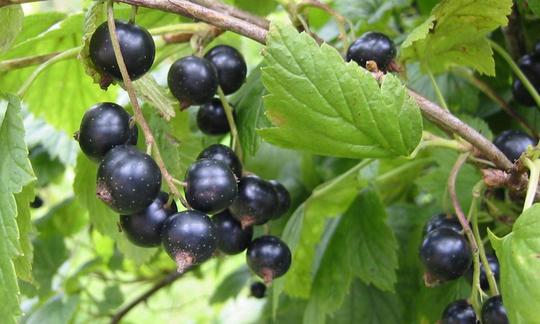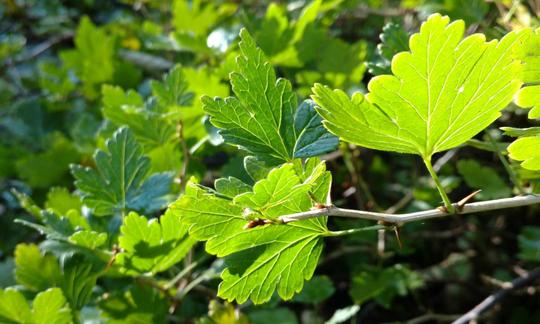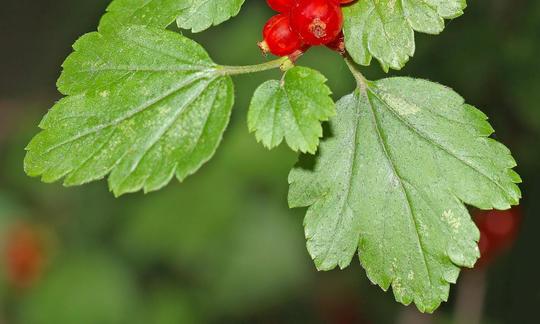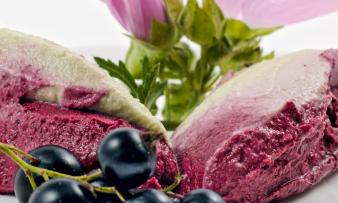Table of contents
Redcurrant leaves, i.e. the leaves of the redcurrant ( Ribes rubrum) and the blackcurrant ( Ribes nigrum), can be used as a tasty ingredient in the kitchen - raw or cooked (preferably organic). The leaves, especially those of the blackcurrant, are also used as a recognized medicinal product.
Use in the kitchen
Are currant leaves edible? The leaves of the red and black currant ( Ribes rubrum and Ribes nigrum) are edible. Young currant leaves are rich in protein and have a slightly mushroom-aromatic, refreshing, tart and sour taste. 9 The leaves of the black currant smell of cassis and are considered to have a more intense flavor than those of the red currant.
How can you eat blackcurrant leaves? The chopped raw leaves are used as an addition to raw salads, salad dressings, soups or as part of a vegetable filling (e.g. for dumplings). 9 Dried blackcurrant leaves are often added to herbal tea mixtures. 1 The fresh leaves can also be used to prepare special desserts, such as blackcurrant mousse with coconut and mallow blossoms.
The berries of the two species, black currant (Cassis) and red currant, are also edible and can be used in the kitchen. You can find out more about this in the related articles.
Vegan recipe for blackcurrant leaf lemonade
Ingredients (for ½ liter): 25 g young blackcurrant leaves (raw, organic), 300 ml boiling water, juice of ½ lemon, 3 tablespoons sugar, 200 ml cold water (alternatively: sparkling water).
Preparation: Rinse the blackcurrant leaves and chop into small pieces. Place in a heatproof container and pour boiling water over them. Allow to cool slightly. Add the lemon juice and sugar and stir. Cover and place in the fridge overnight. The next day, pour the liquid through a sieve into a jug. Add 200 ml of cold, still water or sparkling water and enjoy the vegan blackcurrant leaf lemonade.
preparation
Tea Can you make blackcurrant leaf tea yourself? To make a tea from blackcurrant leaves, pour 2-4 g (daily dose 6-12 g) of finely chopped leaves into approx. 150 ml of boiling water. Alternatively, you can put the leaves in a cold brew and bring them to the boil briefly. The blackcurrant leaf tea is left to steep covered for 5-10 minutes before being strained through a tea strainer. Drink a cup of this several times a day. 2,3 Blackcurrant leaf tea is said to be helpful for dropsy, urinary retention and rheumatism. 10
For urinary tract problems, you can use a bladder and kidney tea, which contains blackcurrant leaves as well as medicinal plants such as orthosiphon leaves, restharrow root, goldenrod, birch leaves or nettle leaves. 3,4
A mixture of dried blackcurrant leaves, raspberry leaves, blackberry leaves, rose hips, marigold blossoms and bitter orange peel is suitable as a home tea. 5
A tea made from red currant leaves is recommended for arteriosclerosis and to purify the blood. This is also said to have a positive effect on internal organs such as the stomach, liver, lungs and bladder. 9
Vegan recipes with currant leaves can be found under the note: " Recipes that have the most of this ingredient ".
| Not only vegans or vegetarians should read this: Vegans often eat unhealthily. Avoidable nutritional errors. |
Purchasing - Storage
Supermarket chains such as Coop, Migros, Denner, Volg, Spar, Aldi, Lidl, Rewe, Edeka, Hofer and Billa as well as the organic supermarkets Denn's Biomarkt and Alnatura do not currently have any blackcurrant leaves (raw or dried) in their range. However, dried blackcurrant leaves (primarily from blackcurrants) can be found in online shops or pharmacies. Blackcurrant leaves are also often included in tea blends. Ready-made blends with blackcurrant leaves can be found in drugstores or possibly in health food stores.
Of course, you can also pick fresh currant leaves yourself. More on this in the following chapter "Finding them in the wild".
The availability of blackcurrant leaves varies depending on the size of the store, catchment area, etc. You can find our recorded food prices for the DA-CH countries above under the ingredient image - and by clicking you can see their development at various suppliers.
Found in the wild
In Central and Eastern Europe, currants are occasionally found in the wild. 2,12 They are part of the shrub layer in the plains and hills. 12 The wild plant grows in humus-rich deciduous and alluvial forests, moist bushes and forests, and in alder groves. 5,6,9,10
In Switzerland (probably in all DA-CH countries) you can find both the red currant ( Ribes rubrum) and the black currant ( Ribes nigrum) cultivated as berry bushes or occasionally growing wild. 11,13
Season : The main flowering period of the black currant is from the end of April (or the beginning of May) to the end of May. The leaves are harvested during or shortly after the flowering period in early summer (June). The ripe berries are picked in mid-summer (July, August). 6, 9,10,14
When harvesting, make sure to only collect leaves that are free from fungal infections. 10
Storage tips
Dried blackcurrant leaves should be stored in a dry place and protected from light. Suitable containers for storage are metal cans, sealable paper bags with aroma protection or dark glass jars with screw caps. Raw leaves are best used fresh. You can also store them in the fridge for a few days or air dry them in a place protected from the sun.
Ingredients - Nutritional values - Calories
The blackcurrant leaf contains carbohydrates, protein and fat as well as minerals such as calcium, magnesium, phosphorus and potassium, trace elements such as iron and manganese as well as vitamin C. 10,12,15,16
The protein, fat and mineral content of the leaves depends, among other things, on the time of harvest. 16
The complete ingredients of blackcurrant leaves, the coverage of the daily requirement and comparison values with other ingredients can be found in our nutrient tables. In the article Nutrients explained you will get a detailed insight into the topic.
Effects on health
Studies over the last few decades have confirmed that extracts from blackcurrant leaves have a positive effect on health, particularly due to their anti-inflammatory and antioxidant effects. 15 Many of the health-promoting effects are due to secondary plant substances (see next chapter), but the nutrients they contain, such as fatty acids, vitamin C and minerals, can also have a positive effect on health.
The fatty acids contained in blackcurrant leaves are mainly unsaturated fatty acids (such as α-linolenic acid, γ-linolenic acid, cis-7,10,13-hexadecatechin, stearidine, phosphatidylcholine, phosphatidylglycerol). They have anti-cancer, antibacterial and anti-inflammatory properties. In addition, blackcurrant leaves have a dietary benefit due to the ratio of potassium to sodium : the high amount of potassium in relation to the amount of sodium causes the diuretic effect of blackcurrant leaves. 16
In addition, the leaf extract of the wild black currant has been shown to have an antiviral effect against the influenza virus A. 12
Secondary plant substances
Many of the health effects of currant leaves can be attributed to the secondary plant substances they contain. Our article on secondary plant substances provides an overview of the classification of substance groups, their occurrence in foods and possible effects on humans. Currant leaves (especially those of the black currant) contain the following secondary plant substances, among others: 5, 9,10,12,14,15,16,17
- Isoprenoids: monoterpenes, diterpenes, sesquiterpenes, carotenoids
- Polyphenols: flavonoids (flavonols (such as kaempferol, quercetin, myricetin, rutin, catechins), anthocyanins (such as delphinidin), proanthocyanidins/procyanidins), phenolic acids (chlorogenic acid, neochlorogenic acid, p-coumaric acid, salicylic acid, gallic acid, quinic acid, caffeic acid, sinapic acid, ferulic acid), tannins
However, it should be noted that the composition of secondary plant substances in currant leaves can vary depending on the variety, time of harvest and growing conditions. Therefore, quantities are only of limited use and should only be understood roughly.
Blackcurrant leaves are rich in bioactive compounds, making them a potential nutraceutical. They contain high concentrations of phenolic compounds with strong antioxidant activity. These compounds could play an important role in risk reduction and prevention of many chronic non-communicable diseases. 16
The leaves of the blackcurrant have higher amounts of polyphenols than the blackcurrant fruit. They also have greater antioxidant activity and stronger anti-inflammatory properties than the berries and other parts of this plant. 12,16
The typical smell of fresh blackcurrant leaves is related to their content of essential oils, which include monoterpenes and sesquiterpenes. 16
Dangers - Intolerances - Side effects
No side effects are known to date for blackcurrant leaves. 7,10 Likewise, no case of overdose has been reported to date. 4
Due to a lack of or insufficient data, the HMPC ( Committee on Herbal Medicinal Products) does not recommend the use of blackcurrant leaves during pregnancy and breastfeeding, or in children and adolescents under 18 years of age. 7
Patients who are advised to reduce their fluid intake, e.g. in cases of severe heart and kidney disease, should not take medicines containing blackcurrants. 7
Use as a recognized medicinal plant
ESCOP ( European Scientific Cooperation on Phytotherapy) and HMPC ( Committee on Herbal Medicinal Products) recognize the leaves of the blackcurrant as a traditional herbal medicinal product.
HMPC cites mild joint pain and mild urinary tract complaints as reasons for the medicinal use of blackcurrant leaf preparations. The leaves increase the amount of urine and thus flush the urinary tract. 2,7 Adequate fluid intake is required during treatment.
In principle, its use does not require medical supervision. However, if symptoms persist for more than 2 weeks (urinary tract problems) or 4 weeks (joint pain) while using the medicine, the HMPC recommends consulting a medical professional. 7
ESCOP lists dried blackcurrant leaves as an adjuvant in the treatment of rheumatic diseases. 8 Use 20-50 g of blackcurrant leaves per liter of water. Allow to brew for 15 minutes. Drink 250-500 ml of this preparation per day. Take 5 ml of the liquid extract (1:1) twice a day before meals. 4
Folk medicine - natural medicine
Since currants became known in Northern Europe in the 16th century, the medicinal plant has been used as a diuretic. 2
Today, in addition to the uses mentioned by HMPC and ESCOP, blackcurrant leaves are used for gout, rheumatism, arthritis, kidney stones, dropsy, diarrhea and whooping cough. The leaves can be applied fresh or crushed to insect bites and wounds. 2,5,9,10 They are also used to gargle for sore throats and mouth ulcers. 14
After taking curative blackcurrant leaf tea, rheumatism and gout attacks may become less frequent and less severe. 10
Ecological footprint - animal welfare
The CO 2 footprint of a food depends on various aspects, such as cultivation method (conventional/organic), seasonality, country of origin, transport and, if applicable, packaging. We have not found any specific data on the CO 2 footprint of currant leaves. However, we have found data on that of raw currants (red and black). According to the Danish climate database Concito, this is 0.69 kg CO 2 eq/kg. 18
According to a Dutch study from 2011, the water footprint of currants is 449 litres of water per 1 kg of berries. 19
In conventional agriculture, synthetic insecticides and herbicides are often used to combat unwanted plants and insects. These have been proven to have a negative impact on the environment and affect important pollinators, birds and mammals. Accordingly, when purchasing currant products, you should choose organic products in order to protect biodiversity and your own health, among other things. The use of such pesticides is prohibited in organic farming.
For detailed explanations of various sustainability indicators (such as ecological footprint, CO2 footprint, water footprint), see our article: What does the ecological footprint mean?
Worldwide occurrence - cultivation
The original distribution area of the red currant ( Ribes rubrum) is Western Europe. 20 The black currant ( Ribes nigrum) is native to temperate climates in Europe, North Asia and Central Asia. 21
Currants have been cultivated since the 15th century. 5 Today they are grown throughout Northern Europe, Asia, North America, in mountainous regions of South America and northwest Africa. Red (and white) currant bushes, but especially black currants, are cultivated mainly for their tasty and abundant fruits. 16 Russia, Poland, Ukraine, the United Kingdom and Germany were the 5 main producing countries of currants in 2022 (unspecified). 22
Growing your own
currant bushes can be planted in the garden. They prefer deep, humus- and nutrient-rich soils in sunny to partially shaded locations. Black currants are more tolerant of soil moisture (temporary dryness and temporary waterlogging) than red currants. 23
Container plants can be planted all year round, but the best time is autumn or early spring. The planting hole should be filled with mature compost and the shoots of the plant should be cut back by two thirds after planting. In autumn, the plant can be fertilized by spreading rotting manure, nettle manure or wood chips on the surface. Regular mulching keeps the soil moist and protects the roots. 23
Red currant bushes are pruned differently than black currants. Red currants develop the most berries on short side shoots (two to three years old), while black currants produce the best harvest on one-year-old wood. 23
Most currants are ready for harvest between June and July. Black currants tend to ripen a little later than red currants. The later you harvest currants, the sweeter they taste. 23
Further information
In addition to the black currant ( Ribes nigrum) and the red currant ( Ribes rubrum), the gooseberry ( Ribes uva-crispa) belongs to the genus Currants ( Ribes) within the gooseberry family ( Grossulariaceae ).
The origin of the name is due to the ripening time around St. John's Day (24 June). 3
Alternative names
The currant is also known colloquially as Ahlbeere, Gichtbeere, Träuble, Kanstraube, Gehonstraube, Trübeli, Meertrübeli and Ribiseln (or Ribisel). Common names for the leaves of the currant (currant leaves, red currant leaves) are Ahlbeerblätter, Bocksbeerblätter, Gichtbeerblätter, Wanzenbeerblätter and Ribisel leaves.
In English, the leaves of the blackcurrant are called currant leaves.
The drug name for the fruits of the black currant is Ribis nigri fructus (formerly Fructus ribis nigri), and that for the leaves is Ribis nigri folium (formerly Folia ribis nigri). 10
Bibliography - 23 Sources (Link to the evidence)
| 1. | Bown D. The Royal Horticultural Society. Encyclopedia of Herbs & their Uses. Dorling Kindersley: London; 1995: 341. |
| 2. | Blaschek W (Herausgeber). Wichtl – Teedrogen und Phytopharmaka. Ein Handbuch für die Praxis. Wissenschaftliche Verlagsgesellschaft mbH: Stuttgart; 2016. |
| 3. | Kooperation Phytopharmaka. Johannisbeere. |
| 4. | Schilcher H, Kammerer S, Wegener T. Leitfaden Phytotherapie. Elsevier GmbH: München; 2007. |
| 5. | Niederegger O, Mayr C. Heilpflanzen der Alpen. Gesundheit aus der Natur von A bis Z. Tyrolia-Verlag: Innsbruck; 2006: 146-147. |
| 6. | Mabey R. essbar: Wildpflanzen, Pilze, Muscheln für die Naturküche. Bern: Haupt Verlag; 2013: 172-173. |
| 7. | EMA Europa eu: Ribis nigri folium - herbal medicinal product. |
| 8. | |
| 9. | Fleischhauer SG, Guthmann J, Spiegelberger R. Enzyklopädie Essbare Wildpflanzen. 2000 Pflanzen Mitteleuropas. AT Verlag: Aarau; 2013: 144-146. |
| 10. | Pahlow M. Das grosse Buch der Heilpflanzen. Gesund durch die Heilkräfte der Natur. Nikol Verlagsges. mbH: Litauen; 2013: 174-175. |
| 11. | Infoflora: Ribes rubrum L. |
| 12. | Ehrhardt C, Dudek SE et al. A plant extract of Ribes nigrum folium possesses anti-influenza virus activity in vitro and in vivo by preventing virus entry to host cells. PLoS One. 2013;8(5):e63657. |
| 13. | Infoflora: Ribes nigrum L. |
| 14. | Chevallier A. Das grosse Lexikon der Heilpflanzen. Dorling Kindersley Verlag GmbH: München; 2017: 262. |
| 15. | Staszowska-Karkut M, Materska M. Phenolic composition, mineral content, and beneficial bioactivities of leaf extracts from black currant (Ribes nigrum L.), raspberry (Rubus idaeus), and aronia (Aronia melanocarpa). Nutrients. 2020;12(2):463. |
| 16. | Ziobroń M, Kopeć A et al. Basic chemical composition and concentration of selected bioactive compounds in leaves of black, red and white currant. Applied Sciences. 2021;11(16):7638. |
| 17. | Cortez RE, Gonzalez de Mejia E. Blackcurrants (Ribes nigrum): a review on chemistry, processing, and health benefits. J Food Sci. 2019;84(9):2387-2401. |
| 18. | The Big Climata Database. Version 1.1. Currant, black. Currant, red. 2024. |
| 19. | Mekonnen MM, Hoekstra AY. The green, blue and grey water footprint of crops and derived crop products. Hydrol. Earth Syst. Sci. 2011;15:1577-1600. |
| 20. | Royal Botanical Garden Kew. Plants of the World Online. Ribes rubrum L. |
| 21. | Royal Botanical Garden Kew. Plants of the World Online. Ribes nigrum L. |
| 22. | FAOSTAT Food and Agriculture Organization of the United Nations. Currants (Production Quantity 2022). |
| 23. | Mein schöner Garten: Johannisbeeren. 2023. |










Comments